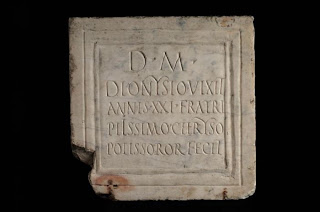When I teach Latin in the summer, I am usually placed in a so-called "smart" classroom, which has built-in multi-media capabilities. However, this fall I am in an old-fashioned classroom, and thus have to lug the multi-media in on my own. Which is why this morning found me hauling an LCD projector and laptop into the classroom and fiddling with them while my students wrote their quiz. Yes, today was their first introduction to Roman inscriptions! And here's what I showed them (Warning: Roman tomb inscriptions can be quite powerful!):
The inscription from the Pantheon in Rome! Translated, it reads "Marcus Agrippa, son of Lucius, made [this] during his third consulship." Agrippa, the son-in-law and close friend of Augustus, did indeed oversee the construction of the Pantheon in 27 B.C. However, his edition of the building burned down in A.D. 80, and was rebuilt under Hadrian. Hadrian, however, decided to go with the original inscription.
One of the inscriptions from the Arch of Titus (actually constructed by Domitian in about A.D. 81). "The Senate and the People of Rome [dedicate this] to the divine Titus, son of the divine Vespasian, and to Vespasian Augustus." The little holes in the letters are nail-holes; originally, there were inset bronze letters, but these have been looted. Interestingly, the name of the emperor does not appear here. This omission is possibly the result of Domitian trying to distance himself from his brother Titus, whom he quite possibly murdered.
Leaving aside public architecture, here we have the base of a statue from Britain. The inscription reads: "The soothsayer Lucius Marcius Memor gives [this] as a gift to the goddess Sulis." Sulis was a Celtic deity associated with the hot-springs at Aquae Sulis (literally, "Waters of Sulis"), the city now known as "Bath." What's interesting about this particular inscription is the tremendous use of ligatures, which is what you get when you combine two or more letters into one. Note, for example, the "M," "A," and "R" in "Marcius." Incidentally, we still make use of a common Latin ligature; it's "&," which is comprised of an "e" and a "t" squashed together, thus giving you the Latin word "et," meaning "and."
Most of our Latin inscriptions come from tombstones, of course (I mean, where would you go if you wanted to see a bunch of English inscriptions in one place?). Here's one that reads: "To the divine Shades and to Dionysius her most pious brother, [who] lived 21 years, Chrysopolis, his sister, made [this]." Given that we have Greek names showing up on a Latin inscription, it's very likely that both Chrysopolis and Dionysius were slaves. Obviously, though, they'd managed to salt away enough money to afford a tombstone; either that, or they had a master generous enough to pay for it himself and let Chrysopolis put her name on it. In either case, they were probably skilled slaves; field-hands or galley-slaves would not have been able to afford something like this.
This one's rather sweet, I think. We have here the tomb of a young boy. The inscription reads: "To the divine Shades of Anthus. Lucius Julius Gamus, his father, [made this] for his most sweet son." I particularly like the puppy; the Romans did keep pets (cats, dogs, birds, etc.), and if we are to judge by the image here, young Anthus had a little dog of whom he was fond.
"To the divine Shades of Minicia Marcella, daughter of Fundanus. She lived for 12 years, 11 months, 7 days." We actually know a little bit about Minicia Marcella. Her father, Fundanus, was a good friend of the writer Pliny the Younger, and thus we have the following, from a letter written by Pliny:
"Caius Plinius greets his friend Marcellinus." (i.e. "Dear Marcellinus") "I, very sad, write these things to you, the younger daughter of our friend Fundanus having died. I have seen no-one anywhere more pleasant, more lovable, or more worthy of a longer life than that girl. She had not completed 13 years, but already had the wisdom of an old woman, the dignity of a matron, and yet a girlish sweetness. How she clung to her father's neck! How both lovingly and modestly she embraced us, her father's friends! How she loved her nurses, her tutors..." The letter goes on to complete the portrayal of a well-educated, well-brought-up, and immensely beloved young lady.
And, finally, my favourite. This one's from northern England, up near Hadrian's Wall. The grammar in the inscription is a bit shaky, but, loosely translated, it reads: "To the divine Shades. Regina, freedwoman and wife, Catuvellaunian by nation, lived 30 years. Barates the Palmyrene [made this for her]." We have here the story of a man (Barates) from Syria moving to northern Britain, and one wonders how he dealt with his first British winter. There, he falls in love with one of his slaves, a Celtic woman named Regina (the Catuvellauni were one of the Celtic tribes of Britain). He subsequently frees and marries her, and I would take this opportunity to point out that neither of those would have been necessary if all he'd wanted to do was sleep with her. After her death, he commissions an enormous, elaborate tombstone (compare it to that of Minicia Marcella, whose father had been consul!). And, as a final touch, he adds, at the bottom of the inscription, a single line in Aremaic, his first language. It reads, poignantly, "Regina of the Catuvellauni, alas!" I nice little story, I think!
Anyway, the class seemed to enjoy looking at the inscriptions, which was the main thing. Hopefully, as well, it will have gone some way to reminding them that we are actually dealing with REAL people who ACTUALLY EXISTED! This message sometimes get lost when one is working almost exclusively with the canon of Latin literature.
Friday, October 24, 2008
Inscriptions!!
Labels:
Archaeology,
Inscriptions,
Language,
Latin,
Pictures,
Romans,
Teaching
Subscribe to:
Post Comments (Atom)





No comments:
Post a Comment